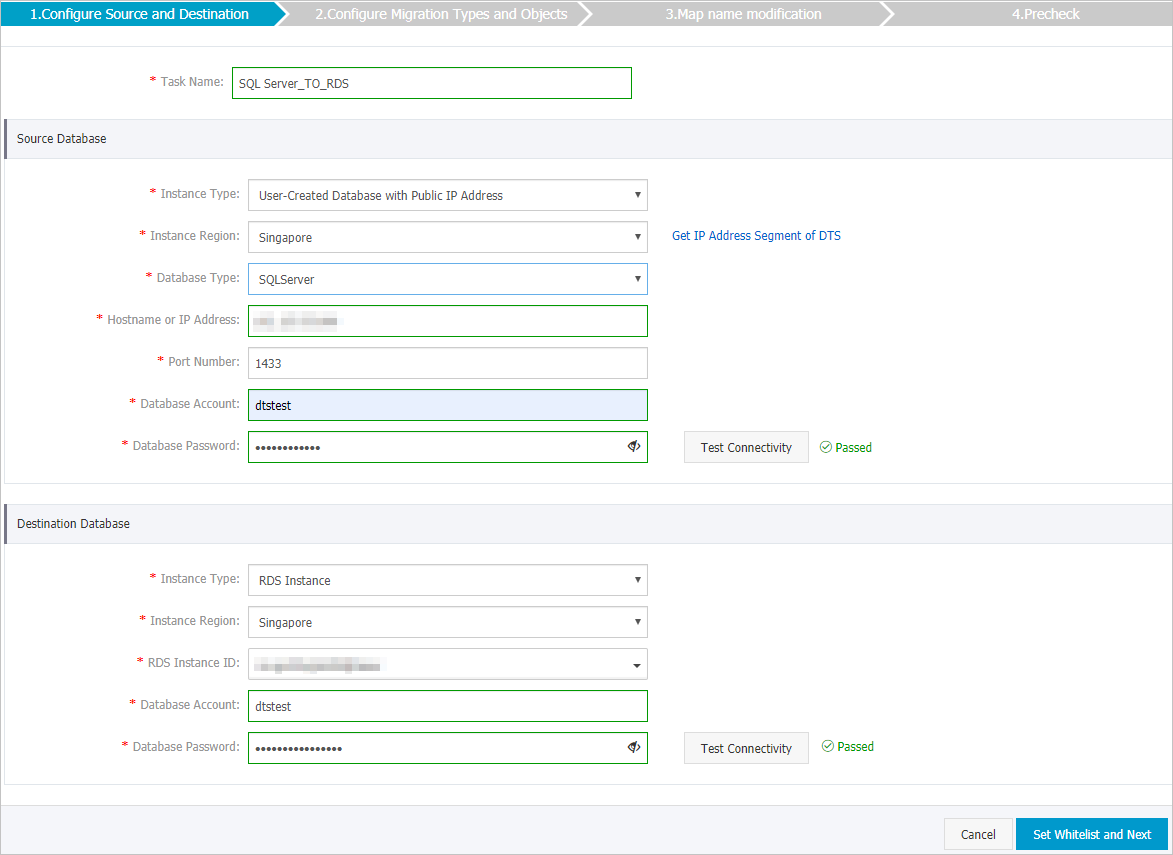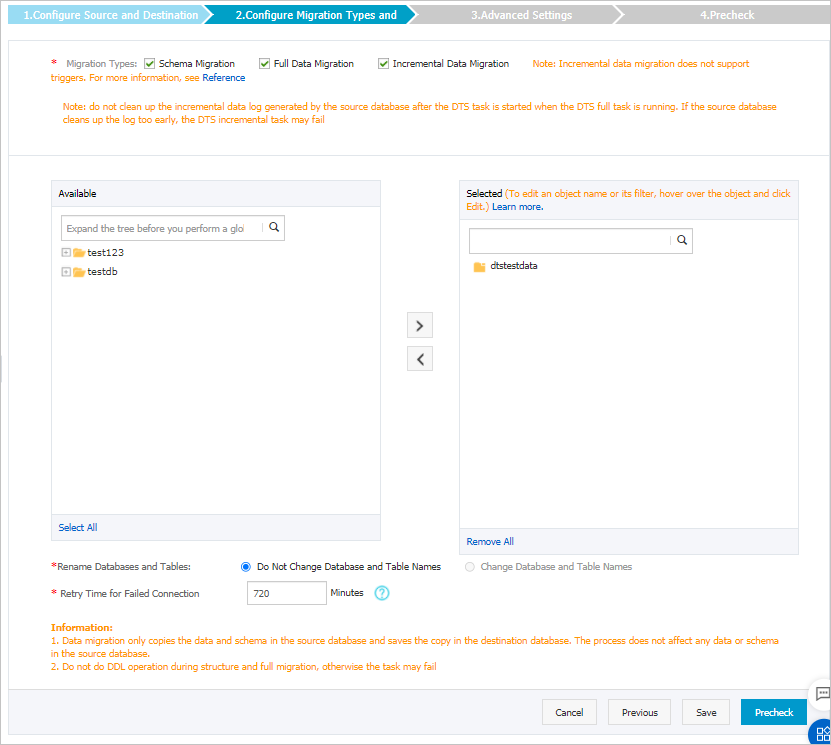This topic describes how to migrate full data from a self-managed SQL Server database to an ApsaraDB RDS for SQL Server instance by using Data Transmission Service (DTS). DTS supports schema migration, full data migration, and incremental data migration. To migrate full data from a self-managed SQL Server database, you can select Schema Migration and Full Data Migration as the migration types.
For information about how to migrate data without service disruptions, see Migrate incremental data from a self-managed SQL Server database to an ApsaraDB RDS for SQL Server instance.
Prerequisites
The version of the self-managed SQL Server database is 2005, 2008, 2008 R2, 2012, 2014, 2016, 2017, or 2019.
NoteIf a primary/secondary switchover is performed in an SQL Server cluster or Always On availability group (AOAG), the log serial numbers of the primary database and the secondary database become inconsistent. In this case, DTS considers that the source database does not support resumable transmission, and the migration task fails. Therefore, you cannot use an SQL Server cluster or an SQL Server AOAG as the source database.
If you migrate data between different versions of databases, make sure that the database versions are compatible.
The available storage space of the ApsaraDB RDS for SQL Server instance is larger than the total size of the data in the self-managed SQL Server database.
Precautions
DTS uses read and write resources of the source and destination databases during full data migration. This may increase the loads of the database servers. If the database performance is unfavorable, the specification is low, or the data volume is large, database services may become unavailable. For example, DTS occupies a large amount of read and write resources in the following cases: a large number of slow SQL queries are performed on the source database, the tables have no primary keys, or a deadlock occurs in the destination database. Before you migrate data, evaluate the impact of data migration on the performance of the source and destination databases. We recommend that you migrate data during off-peak hours. For example, you can migrate data when the CPU utilization of the source and destination databases is less than 30%.
The tables to be migrated in the source database must have PRIMARY KEY or UNIQUE constraints and all fields must be unique. Otherwise, the destination database may contain duplicate data records.
DTS automatically creates a destination database in the ApsaraDB RDS for SQL Server instance. However, if the name of the source database does not conform to the naming conventions of ApsaraDB RDS, you must create a database in the ApsaraDB RDS for SQL Server instance before you configure the data migration task.
NoteFor more information about the database naming conventions and how to create a database in ApsaraDB RDS for SQL Server, see Create a database on an ApsaraDB RDS for SQL Server instance.
If a data migration task fails, DTS automatically resumes the task. Before you switch your workloads to the destination instance, stop or release the data migration task. Otherwise, the data in the source database will overwrite the data in the destination instance after the task is resumed.
Limits
DTS does not migrate data of the SQL_VARIANT type.
DTS does not migrate the schemas of assemblies, service brokers, full-text indexes, full-text catalogs, distributed schemas, distributed functions, CLR stored procedures, CLR scalar-valued functions, CLR table-valued functions, internal tables, systems, or aggregate functions.
Migration types
Schema migration
DTS migrates the schemas of the required objects to the destination instance. DTS supports schema migration for the following types of objects: table, view, trigger, synonym, SQL stored procedure, SQL function, plan guide, user-defined type, rule, default, and sequence.
Full data migration
DTS migrates historical data of the required objects from the self-managed SQL Server database to the destination database in the ApsaraDB RDS for SQL Server instance.
Billing
Migration type | Task configuration fee | Internet traffic fee |
Full data migration | Free of charge | Charged only when data is migrated from Alibaba Cloud over the Internet. For more information, see Billing overview. |
Permissions required for database accounts
Database | Schema migration | Full data migration |
Self-managed SQL Server database | The SELECT permission | The SELECT permission |
ApsaraDB RDS for SQL Server instance | The read and write permissions | The read and write permissions |
For information about how to create and authorize a database account, see the following topics:
Self-managed SQL Server database: CREATE USER
ApsaraDB RDS for SQL Server instance: Create an account for an ApsaraDB RDS for SQL Server instance.
Process of full data migration
To prevent data migration failures caused by dependencies among objects, DTS migrates the schemas and data from the source SQL Server database in the following order:
Migrate the schemas of tables, views, synonyms, user-defined types, rules, defaults, and plan guides.
Perform full data migration.
Migrate the schemas of SQL stored procedures, SQL functions, triggers, and foreign keys.
Procedure
Log on to the DTS console.
NoteIf you are redirected to the Data Management (DMS) console, you can click the
 icon in the
icon in the  to go to the previous version of the DTS console.
to go to the previous version of the DTS console.In the left-side navigation pane, click Data Migration.
In the upper part of the Migration Tasks page, select the region in which the RDS instance resides.
In the upper-right corner of the page, click Create Migration Task.
Configure the source and destination databases.

Section
Parameter
Description
N/A
Task Name
DTS automatically generates a task name. We recommend that you specify an informative name for easy identification. You do not need to use a unique task name.
Source Database
Instance Type
Select an instance type based on the deployment of the source database. In this example, select User-Created Database with Public IP Address.
NoteIf you select other instance types, you must deploy the network environment for the self-managed database. For more information, see Preparation overview.
Instance Region
If the instance type is set to User-Created Database with Public IP Address, you do not need to specify the Instance Region parameter.
NoteIf a whitelist is configured for the self-managed SQL Server database, you must add the CIDR blocks of DTS servers to the whitelist of the database. You can click Get IP Address Segment of DTS next to Instance Region to obtain the CIDR blocks of DTS servers.
Database Type
Select SQLServer.
Hostname or IP Address
Enter the endpoint that is used to connect to the self-managed SQL Server database. In this example, enter the public IP address.
Port Number
Enter the service port number of the self-managed SQL Server database. The default port number is 1433.
NoteThe service port of the self-managed SQL Server database must be accessible over the Internet.
Database Account
Enter the account that is used to log on to the self-managed SQL Server database. For information about the permissions that are required for the account, see Permissions required for database accounts.
Database Password
Enter the password of the database account.
NoteAfter you specify the information about the source database, you can click Test Connectivity next to Database Password to check whether the information is valid. If the information is valid, the Passed message appears. If the Failed message appears, click Check next to Failed. Then, modify the information based on the check results.
Destination Database
Instance Type
Select RDS Instance.
Instance Region
Select the region where the destination RDS instance resides.
RDS Instance ID
Select the ID of the destination RDS instance.
Database Account
Enter the database account of the destination RDS instance. For information about the permissions that are required for the account, see Permissions required for database accounts.
Database Password
Enter the password of the database account.
NoteAfter you specify the information about the RDS instance, you can click Test Connectivity next to Database Password to check whether the information is valid. If the information is valid, the Passed message appears. If the Failed message appears, click Check next to Failed. Then, modify the information based on the check results.
In the lower-right corner of the page, click Set Whitelist and Next.
NoteDTS adds the CIDR blocks of DTS servers to the whitelist of the destination RDS instance. This ensures that DTS servers can connect to the destination RDS instance.
Select the migration types and the objects to be migrated.

Setting
Description
Select the migration types
To perform only full data migration, select Schema Migration and Full Data Migration.
To ensure service continuity during data migration, select Schema Migration, Full Data Migration, and Incremental Data Migration.
In this example, select Schema Migration and Full Data Migration.
NoteTo ensure data consistency, we recommend that you do not write data to the self-managed SQL Server database during data migration.
Select the objects to be migrated
Select one or more objects from the Available section and click the
 icon to move the objects to the Selected section. Note
icon to move the objects to the Selected section. NoteYou can select columns, tables, or databases as the objects to be migrated.
By default, after an object is migrated to the destination database, the name of the object remains unchanged. You can use the object name mapping feature to rename the objects that are migrated to the destination database. For more information, see Object name mapping.
If you use the object name mapping feature to rename an object, other objects that are dependent on the object may fail to be migrated.
Specify whether to rename objects
You can use the object name mapping feature to rename the objects that are migrated to the destination instance. For more information, see Object name mapping.
Specify the retry time for failed connections to the source or destination database
By default, if DTS fails to connect to the source or destination database, DTS retries within the next 12 hours. You can specify the retry time based on your needs. If DTS reconnects to the source and destination databases within the specified time, DTS resumes the data migration task. Otherwise, the data migration task fails.
NoteWhen DTS retries a connection, you are charged for the DTS instance. We recommend that you specify the retry time based on your business needs. You can also release the DTS instance at your earliest opportunity after the source and destination instances are released.
Click Precheck.
NoteA precheck is performed before the migration task starts. The migration task only starts after the precheck succeeds.
If the precheck fails, click the
 icon next to each failed check item to view the related details. Fix the issues as instructed and run the precheck again.
icon next to each failed check item to view the related details. Fix the issues as instructed and run the precheck again.
Click Next.
In the Confirm Settings dialog box, configure the Channel Specification parameter. Then, read and select Data Transmission Service (Pay-as-you-go) Service Terms.
Click Buy and Start to start the data migration task.
NoteWe recommend that you do not manually stop a data migration task. Otherwise, the data migrated to the destination instance will be incomplete. You can wait until the data migration task automatically stops.
Switch your workloads to the destination RDS instance.
What to do next
The database accounts that are used for data migration have the read and write permissions. After data migration is complete, you must delete the accounts of both the self-managed SQL Server database and the ApsaraDB RDS for SQL Server instance to ensure security.